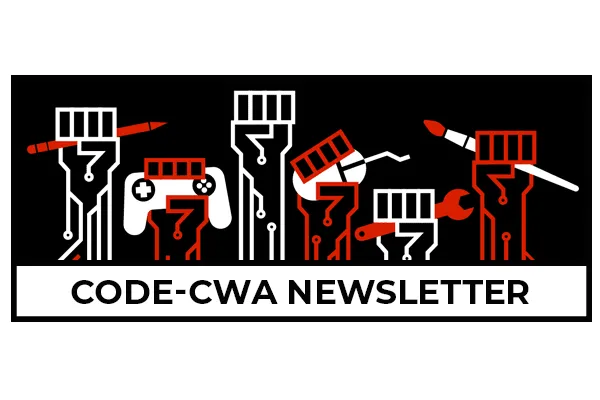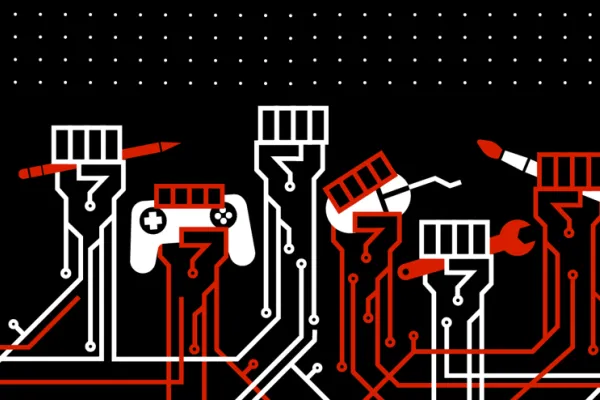CODE-CWA Newsletter: July 24

In this challenging moment, we’re inspired by worker solidarity.
We’re now four months into lockdown for many of us in the United States, and sometimes it feels like the weight of the world is on our shoulders. In addition to a deadly pandemic, the New York Times determined the Black Lives Matter movement to be the largest protest movement in U.S. history. Federal officers have occupied Portland and may be moving into other cities.
It’s okay if you’re feeling alone. It’s okay if you’re feeling existential angst. Let yourself feel your emotions, take a break from the screen, and when you’re ready, we encourage you to turn to your fellow workers for support.
A Law Professor at the Case Western Reserve University of Law was published in Forbes this week writing on a phenomenon that we at CODE-CWA have already observed in conversations with tech workers: The pandemic hasn’t dampened worker organizing in the tech industry; it actually strengthened it. Through organizing, we can take our power back, win a better life for ourselves and our coworkers, and feel less alone.
Trying to organize a union in your company? Get in touch, and let’s build together.
EventsCODE-CWA is still holding free, virtual training sessions about how to get started with organizing! Registration information is online here.
Worker NewsGooglers in the Zürich office, Google’s largest European office, have elected employee representatives. The workers will be organizing with Syndicom, a European union for workers in media and communications. Under Swiss law, these employee representatives meet with management to receive information and consult on managerial decisions. The election is an encouraging step within a company where workers have long struggled to unionize. More on syndicom.ch, auf Deutsch.
A group of workers at The Wall Street Journal is flexing their power to call for the paper’s new publisher to clamp down on the paper’s Opinion section. More than 280 reporters, editors, and other employees signed onto the letter, which reads, “Opinion’s lack of fact-checking and transparency, and its apparent disregard for evidence, undermine our readers’ trust and our ability to gain credibility with sources.” The move came after the Wall Street Journal published an essay by Vice President Mike Pence called “There Isn’t a Coronavirus ‘Second Wave,’” which was later corrected for containing inaccurate figures. More on wsj.com.
Twenty-one Voltage Entertainment workers in the video game industry have gone on strike after management refused to recognize their collective demands. Workers at Voltage are paid half of the industry standard and expected to work long hours. They are also contracted workers, so Voltage Entertainment does not provide them with benefits. This is a historic move for the gaming industry, where employees have struggled to unionize. Workers are encouraging supporters to write “respectful” emails to the company asking management to recognize the workers’ demands. More at polygon.com.
Amazon is exploiting its content moderators. As tech companies have come under fire for poor working conditions for their content moderators, Google, Slack, Facebook, and others have poured money into research on content moderation. Notably absent from this group? Amazon. But Amazon workers say the company is no less exploitative of their employees behind closed doors. Amazon expects workers to review over 20 reports an hour—faster if they want to take breaks. Undoubtedly related to the immense stress moderators are under, users still see inappropriate search results on the platform. Earlier this year, ProPublica and The Atlantic found that over 200 white supremacist book titles were self-published through Amazon. More on thenextweb.com.
Service workers are turning to social media like TikTok and Facebook for support from fellow workers. Before the pandemic, food service workers had made a home on TikTok, telling light-hearted anecdotes about their days. But in the past few months, the content has turned dark, as essential workers have been subject to verbal and sometimes even physical assaults from customers angry about mask policies. More and more service workers are turning to TikTok or support groups on Facebook to commiserate about the impact these high-stress low-pay jobs have had on their mental health. More on technologyreview.com.
Venture capitalists took to an invite-only club for tech’s elite this month to complain about poor relationships with journalists. The VCs characterized negative press their companies received as “snarky hit piece[s],” and even questioned why the industry needed journalists at all. But while bosses are worried about getting “canceled,” tech workers say they have much more to lose. A former worker at Away noted that the negative press the company received last year helped to curb the poor treatment of employees. More at theverge.com.
Workers at Shipt, a Target owned delivery service, went on strike Tuesday to protest inadequate safety measures for workers and a frustrating new pay structure. The organizers of the Shipt protest demand hazard pay of $5 per order, more personal protective equipment, a more transparent pay structure, and two weeks of sick leave. Shipt workers said they were inspired to organize by recent strikes by essential workers at Instacart, Whole Foods, and Amazon. More at latimes.com.
Lyft drivers received an email from company management last week offering to sell them personal protective equipment. A single can of Lyft’s hand sanitizer costs $5.99. The drivers were furious. For months they’ve been out of work, and because Lyft illegally refused to classify them as employees, they’ve struggled to access unemployment insurance and healthcare. Charging drivers for hand sanitizer after already barring them from health insurance, adds insult to injury. Frontline workers should not have to pay for PPE. It’s that simple. More on OneZero.
Organizing Tip of the MonthThe San Francisco chapter of the Democratic Socialists of America released several zines this month with organizing 101 information presented in an easy-to-digest manner. Zine topics include “Why do we need a union?,” “Know your rights organizing in the workplace,” “How do I talk to my coworkers about unionizing?,” and “5 Steps to Underground Organizing.” These are super helpful resources to share and distribute to trusted coworkers!
Labor HistoryThe Great Railroad Strike of 1877, also known as the Great Upheaval, started in mid-July.
Workers at the Baltimore and Ohio (B&O) Railroad in Martinsburg, West Virginia, rose after the railroad cut wages for the third time in a single year. On July 16, they declared that no train would leave the station until railroad owners restored their pay. Notably, the workers were able to garner support from their community, and their numbers dwarfed local police response to the movement.
The Mayor of Martinsburg called in the National Guard, which shut down the strike quickly. But the movement was not over, as strikes promptly spread throughout the country. At the movement’s peak, strikes raged on in New York, Pennsylvania, Maryland, Illinois, and Missouri.
Strikes eventually ended the first week in August, due to a combination of federal force and waning energy on behalf of the strikers. By that point, the guard had killed over 100 people and imprisoned a thousand more. Over 100,000 workers had gone on strike and shut down nearly half of the country’s railways. Strikers also inflicted millions of dollars in damages to bosses’ property.
By some metrics, the strike was a failure. In limited cases, workers had their demands met, but there was no unifying demand between strikes across the country. Workers weren’t organizing to seize the means of production. Thousands of them organically revolted against their employers without prior communication due to shared frustrations with their working conditions.
Perhaps the real success of the movement was the fear it instilled in the minds of the ruling class. Had the Great Upheaval not taken place, it’s impossible to tell how many future wage cuts workers could have experienced.
At the time the Great Upheaval took place, workers were not represented by unions. Following the strike, workers continued to communicate and organized into unions. With more organization, workers were better able to negotiate. By 1880, workers at the B&O Railroad pushed their employer to create the B&O Employees’ Relief Association, which provided limited coverage for sickness, workplace injury, or death. By 1884, B&O became the largest U.S. company to offer a pension plan.
Learn more on Wikipedia or ushistory.org.
Railway blockade in Martinsburg, West Virginia (Wikimedia Foundation)
Song of the WeekPete Seeger, “Which Side Are You On?”
Which side are you on boys?
Which side are you on?
Which side are you on boys?
Which side are you on?
They say in Harlan County
There are no neutrals there.
You'll either be a union man
Or a thug for J. H. Blair.
Which side are you on boys?
Which side are you on?
Which side are you on boys?
Which side are you on?
My daddy was a miner,
And I'm a miner's son,
He'll be with you fellow workers
Until this battle's won.
CODE-CWA Newsletter: February 21, 2025

